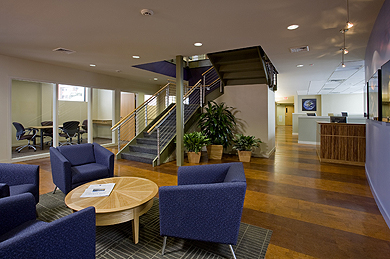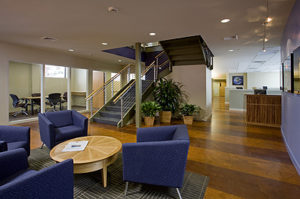
interiors
It has been five years since we completed the LEED-CI Platinum renovation of our Newton headquarters, a project that represented our company-wide commitment to sustainability and marked the beginning of an ongoing pledge of sustainable practices on every project. We transformed our office into a learning lab where we could test green products and systems, a process that gave us a wealth of first-hand knowledge that we could then share with our clients and partners.
So with five years of data to consider, we thought the time was right to review what worked and what didn’t. The improvements we looked at include lighting, water, building materials & finishes, indoor air quality, energy, and the LEED certification process itself.
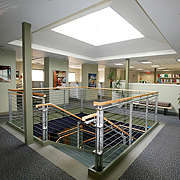 Lighting
Lighting
Our first priority in devising the new lighting strategy for our office was to maximize natural daylight. We started by adding some windows, enlarging others, and installing tubular daylighting devices that funnel sunlight into our space. Next, we tackled the fixtures, reducing our total fixture count by strategically locating them over our employee work stations, where illumination was most essential. We then replaced the fixtures themselves with high efficiency models equipped with T5 lamps and added daylight and occupancy sensors that keep them turned off when not needed.
The results of these efforts have been impressive. Our daylighting strategies have proven so effective that our electric lights can often be off altogether during work hours, with no loss of lighting quality or quantity. These strategies, along with the high efficiency fixtures, have been a major contributor to our energy savings.
We regard our lighting efforts from 2008 as an unqualified success; however, the technological advancements and the falling costs of LEDs make even greater energy savings possible today. The 2×2 light fixtures we installed each run at 80W, but new LED bulbs allow the same fixture to run at 35W or less.
Water
We have five bathrooms and a kitchen at our headquarters that we outfitted with low-flow aerators, dual-flush toilets, and waterless urinals. With just those simple, low-cost changes, our water usage has dropped from over 60,000 gallons to just 18,000 gallons annually – a savings of more than 42,000 gallons per year.
The resulting financial savings have been modest, but the environmental impact is undeniable. In five years we’ve already conserved the equivalent of ten residential swimming pools of potable water, just by changing a few fixtures. In regions where water is at more of a premium, the financial benefits could be more substantial. With increasing concern about water shortages around the country and the world, water conservation is an ecologically equitable and economically responsible measure everyone can take…and it’s easy.
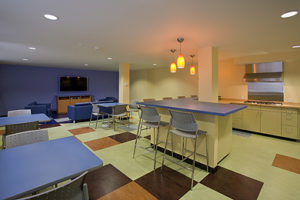
interiors
Building Materials & Finishes
We employed a range of sustainable materials and finishes in our renovation, largely with excellent results. While our rapidly renewable cork flooring hasn’t proved as durable as we’d hoped, the natural agrifiber surfaces we used, including marmoleum flooring, have performed every bit as well as VCT with no added cost. Likewise, the drywall and ceiling tiles made with recycled materials are indistinguishable from their non-recycled counterparts.
The low VOC paints and carpet adhesives we chose have kept our office free of fumes, both during application and in the years since. And although some of the paints have required touch-ups in the heaviest-use areas, they’ve largely performed well. Additionally, manufacturers continue to fine-tune their products, and we’ve experienced improved performance with today’s low – VOC formulations
Indoor Air Quality
For the health of both the construction team and current/future occupants, careful implementation of an indoor air quality plan is a must on any project. For the renovation of our office – which was fully occupied throughout construction – we developed a comprehensive plan to control and contain contaminants, while also selecting products paints, adhesives, coatings, and sealants that had low or no emissions.
In redesigning our space, we also created a separately vented copy area to prevent equipment emissions from mixing with the main office circulation. In some areas, we also installed operable windows to allow for natural ventilation that many offices lack.
We’ve been so pleased with the results of our IAQ efforts that we’ve adopted that plan as a standard practice on all of our projects.
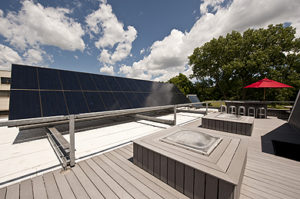
Client: Chapman Construction, (617) 630-8408 84 Winchester St. Newton, MA 02481
Project: Chapman Corporate Office Solar System
For more information Contact Gregg Shupe 508-877-7700 www.Shupestudios.com
Energy
Perhaps the most ambitious goal of our renovation was to shrink our office’s energy footprint, and we approached it from several angles. As described above, we maximized natural lighting and reduced the count and wattage of our light fixtures to create significant energy savings. We then used TPO and paint on acrylicoating to turn our building’s roof from black to white, reducing the heat island effect and lowering the surface temperature from 180° to 100° on an 80° degree day. This in turn allows our HVAC system to run more efficiently, as its fresh air intake is pulling in much cooler air. We also installed a small solar thermal hot water system that more than covers our relatively low hot water needs.
The most dramatic step we took was the addition of a 47kW photovoltaic array to our roof that produces our own electricity. We had high hopes for our solar panels, and they’ve performed even better than we expected, generating 89% of our already trimmed annual electric bill. During the spring and fall months, we often have production that exceeds our consumption. The extra power gets exported back to the grid for use by others and further reduces our utility bill.
When we installed our array in 2008, the state grants and federal tax incentives made it a very appealing prospect – the system paid for itself in just over four years. The Massachusetts solar programs have evolved from grants and rebates to a production-based incentive, but they remain a significant part of any solar project’s financial structure. These programs, combined with significant reductions in the cost of solar equipment, have helped keep solar a financially viable option in Massachusetts. It’s not suited for every situation, but in the right application, it can deliver a huge benefit.
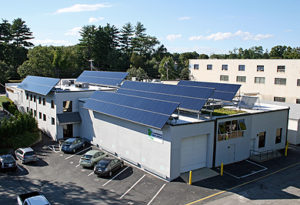
LEED Certification
We sought and achieved LEED-CI Platinum certification from the
USGBC for our renovation, but by no means is certification the only way to execute a sustainable project. Whether it’s warranted on a particular project depends on your needs.
We found the LEED system to be a useful framework for our effort, and one that got us thinking about systems and processes that we might not have otherwise considered. There’s some overhead involved with seeking LEED – mostly in tracking and documenting your efforts – but having a recognized third-party validation of your work can be a real asset. The USGBC’s seal of approval is something that differentiates you and can be helpful in attracting employees, tenants, and clients alike.
Conclusion
Our experience with our own project and countless others has made it clear that there’s no one “right” approach to sustainability – you need a plan that matches your space, your goals, and your budget. But with local and state building codes continually requiring higher levels of efficiency, it’s no longer a question of whether or not to consider sustainability in your project; it’s just a matter of how.
Our renovation gave us a fantastic opportunity to put a range of sustainable systems and products to a real-world test, and to see how they stood up over time. Overall, we have been delighted with the results, and we’ve been able to share the deep understanding we’ve gained with many of our clients and partners – some seeking LEED, some not. Whatever their needs, we act as a trusted advisor, helping them wade through the myriad options to find the right balance for them.


